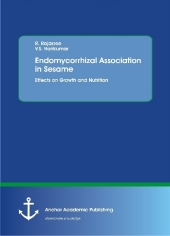 Neuerscheinungen 2016Stand: 2020-02-01 |
Schnellsuche
ISBN/Stichwort/Autor
|
Herderstraße 10
10625 Berlin
Tel.: 030 315 714 16
Fax 030 315 714 14
info@buchspektrum.de |

V. S. Harikumar, R. Rajasree
(Beteiligte)
Endomycorrhizal Association in Sesame. Effects on Growth and Nutrition
2016. 200 S. 75 Abb. 220 mm
Verlag/Jahr: ANCHOR ACADEMIC PUBLISHING 2016
ISBN: 3-9606707-4-5 (3960670745)
Neue ISBN: 978-3-9606707-4-2 (9783960670742)
Preis und Lieferzeit: Bitte klicken
Sesame (Sesamum indicum L.) is recognized as one of the most ancient oils. Its cultivation goes back to 2130 BC. It is cultivated in tropical, subtropical and southern temperate regions of the world for its seeds which are a rich source of edible oil. Recent studies have shown that the oil lowers cholesterol levels and hypertension in humans and reduces the incidence of certain cancers.
India ranks high in the area and production of sesame in the world with an annual area of 2.07 million hectares and total production of 0.76 million tons. Even though sesame is the predominant oil seed crop of India, the per hectare productivity and the economic returns given by it are very low. The crop is very sensitive to biotic and abiotic stresses and it grows in marginal light-textured inceptisols having poor soil fertility associated with imbalance and without fertilizer application. The application of both organic and inorganic fertilizers could help bringing in profitable returns. However, due to escalating costs of production of chemical fertilizers and low subsidies for farmers, the agricultural planners are compelled to re-orient their thinking towards cost effective and cheap renewable resources.
Text sample:
Chapter 3: Arbuscular Mycorrhizal Associations with Field Grown Sesame:
3. 1. Characteristics of sesame soils:
Soil type of the sesame soils was predominantly sandy except in one location where laterite soil was observed. Physico-chemical characteristics of the soil varied significantly between locations (Table 3. 1). Soil moisture varied from 0.47% to 22.83%. In general, pH of the soil was acidic though it ranged from 4.3 to 6.5. The values of soil salinity ranged from 0.10 to 0.62 dSm-1. Nevertheless, none of the sesame soils showed saline nature. Organic carbon levels of the soils ranged from 0.72 to 1.50%. Soil nutrients such as N, P and K also varied significantly in soils. Level of N ranged from 60.10 to 186.8 kgh-1 while P ranged from 26.7 to 230 kgh-1. Soil K level ranged from 12.83 to 192.11 kgh-1. The wide variation in soil physico-chemical characteristics observed in the present study could be attributable to the differences in cropping system and cultural practices received in each field (Christensen, 1988; Soon and Arshad, 1996; Agbenin and Goladi, 1997; Ju et al., 2007).
3. 2. AM colonization:
Root colonization by AM fungi (Fig. 3.1) was highest in sample 18 (80%) and the lowest in sample 4 (5.8%). Out of the total number of samples only 22% had a comparatively high rate of colonization (50%) while 78% of the samples had a low level of colonization (


